DESHNOKE (Day 2)
I was not at all convinced that we would see the van outside the hotel in the morning; I was sure it was a scam. But there it was! We continued on our way, stopping occasionally at roadside chai (hot milky sweet tea) stands, where the locals stared unblinkingly and unflinchingly at us. I felt very British colonial as we all drove through the small towns with our native guide, looking at people and life but being very separated and 'safe' from it all. The only difference between us and the turn of the last century was that we had no trunks tied to the roof.
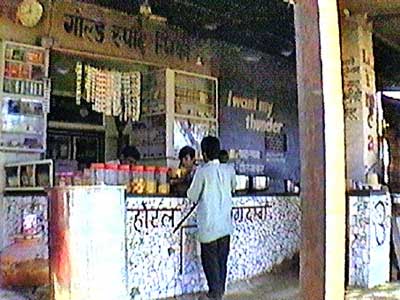
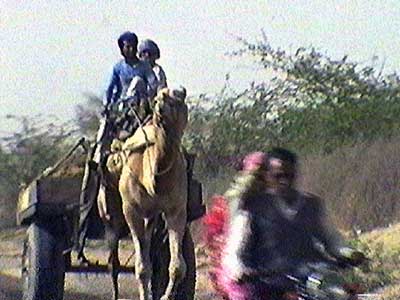
A chai stand ... a camel-drawn cart
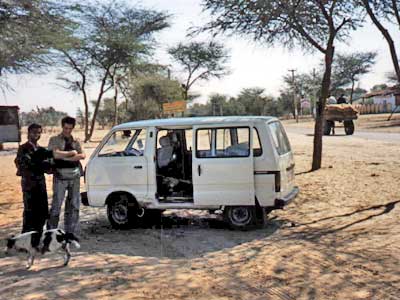
Mukesh and Ron with our mini-van
As we drove, there were fewer towns, fewer trees and more camels. Blowing sand snaked its way across the road and mirages sparkled on the asphalt in the distance. Eventually we arrived at our destination... Shri Karni Mata in Deshnoke. It is famous for its large population of rats.. holy rats, that is... who are welcomed and encouraged to live there. Karni Mata was said to have reincarnated the children who died in a terrible plague into these lively little rodents.
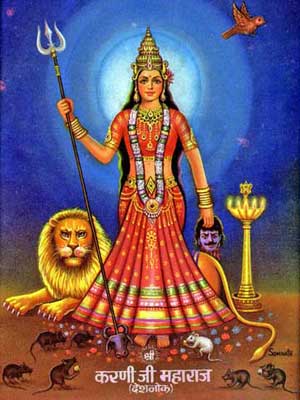
Karni Mata is an incarnation of the goddess Durga


Shri means temple and Mata means mother. ... The main gate


Silver doors depicting Karni Mata and her 'children' ... and the god Ganesh (also with rats)


Ganesh (or Ganesha) is the Hindu god of wisdom and the remover of obstacles. He is the firstborn son of Shiva and Parvati. Stories differ as to why he has an elephant head, but the most common one is that Shiva once cut it off in anger and threw it far away. When Parvait discovered this, she was very upset with her husband and insisted he fix it. But since he couldn't find the original head, Shiva cut off the head of a sleeping baby elephant and used that instead. Every god has some type of animal companion. Shiva has the cobra, Durga has the lion or tiger (see her image above) and Ganesh has the rat. The reason he chose such a small animal to ride around on was that by going so slowly, he could spend more time among the people. In this culture, rats are seen as clever and can penetrate even the most difficult of places.
We took off our shoes (as is required at all holy temples) and went in. Small brown rats scampered everywhere... napping in the corners, resting on the pillars, sleeping on the handrails, climbing up the wall pipes, and nestled in the overhead nets. Mukesh said there were not as many rats as two years ago because many died from some kind of epidemic. The temple was also packed with people too... not tourists, but rather locals who came to pray at this holy place.

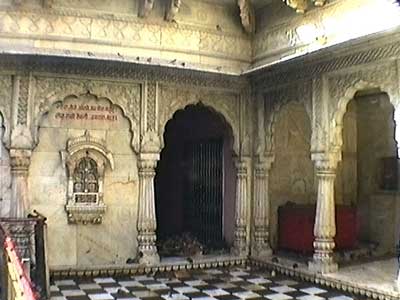

An inner courtyard


Dishes of water, milk and grain were set out for them to enjoy.
Theses were black rats (Rattus rattus) and not the standard pet brown rats (Rattus norvegicus). They were quite tame and did not dart away when someone approached... probably because they knew the person would always stop and give them the right of way.
They all appeared at first to be so small and frail but I later realized that this was not at all the case. Many of them were full of energy, and they bounded, scampered and played with each other. Granted some of them looked quite beaten up with tuffs of fur missing or broken tails, but their daily diet seemed to keep them overall fairly healthy.


The shrine was located inside a small room. As we as tourists weren't allowed in but we were heartily encouraged to take photos. Devotees were gladly offering the rats food from their hands, because if a rat accepted a piece, it was considered to be very good luck.


The rats were well-fed at the shrine.

Touching the sacred rats and shrine
We exited the main temple and headed back out into the large complex. Unlike the inner main temple, most of this area was rather run down. It consisted of an odd combination of small shrines, statues and buildings which were painted in very bright colors ranging from hot pink to bright sky blue. Again, rats were at every level.


An old woman was feeding a small group of rats from a dish. She was bent over them dotingly and it seemed as if she were making sure that every rat got enough to eat.


An overhead net was meant to keep the pigeons out, but it wasn't working. They made far more of a mess than the rats did!
Just then, a little beggar girl ran over to get us. She had found the white rat. Supposedly there are about 4 - 5 white rats living in the temple and it is considered very good luck to see one. Lots of people flocked in when they learned the special animal had been found.
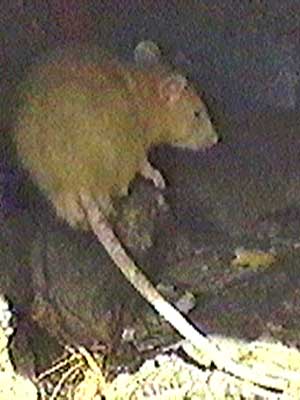
The white rat was actually more beige.
We bought a few souvenirs then drove back to Bikaner where we got a hotel, which was much nicer than the previous one. The beds were softer; the blanket was inside a cover which could be washed; the carpet wasn't threadbare; the bathroom was clean and had a flushing toilet with lid; and there was even wrapped soap and toilet paper. The hotel owner was extremely pleased to hear that we had seen the white rat.
We wanted to go to visit the fort in town but everything was closed due to elections. So we gave Mukesh the evening off and rested at the hotel. It was a lovely warm evening to spend time sitting outside.
return • continue

